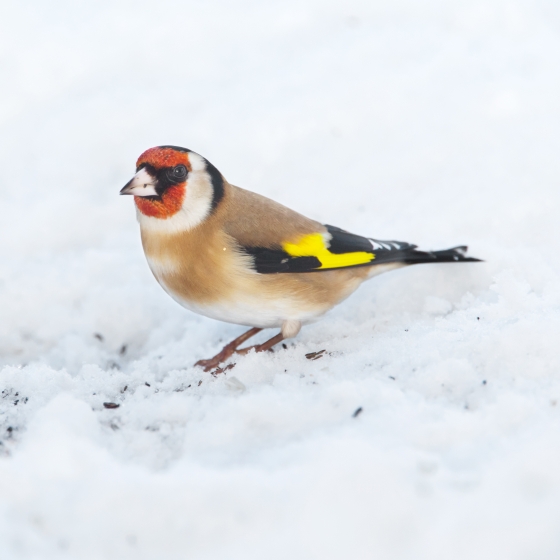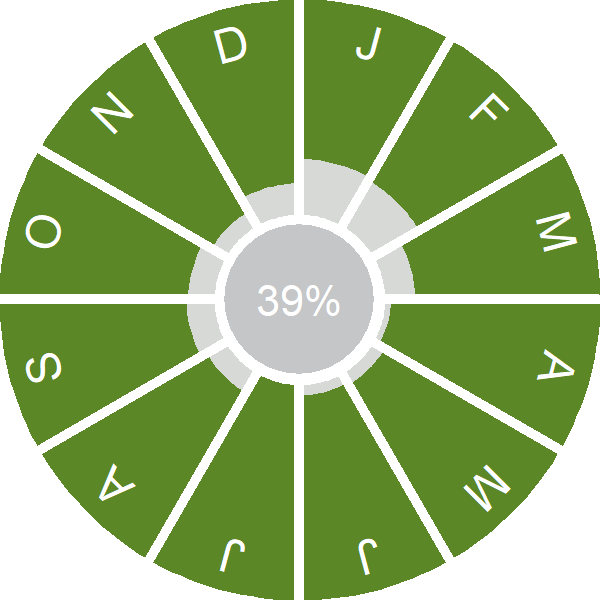Goldfinch
Carduelis carduelis (Linnaeus, 1758)
GO
 GOLDF
GOLDF  16530
16530

Family: Passeriformes > Fringillidae

This colourful and vocal finch is found throughout Britain & Ireland on all but the highest ground.
With its red face and bright yellow wingbars, the Goldfinch is a striking species. Newly-fledged juveniles lack the red facial plumage. Males and females look alike. UK Goldfinch numbers have risen steadily in recent decades, as birds have taken advantage of bird food provided in gardens. The species is on the UK Green List.
Goldfinches can be found throughout the year across Britain & Ireland. When not visiting garden feeders, they form can flocks with other finches, and can be seen moving through trees and on stubble fields in search of food.
Exploring the trends for Goldfinch
Our Trends Explorer will also give you the latest insight into how the UK's Goldfinch population is changing.
trends explorerIdentification
Goldfinch identification is usually straightforward.
SONGS AND CALLS
Listen to example recordings of the main vocalisations of Goldfinch, provided by xeno-canto contributors.
Flight call
Call
Song
Develop your bird ID skills with our training courses
Our interactive online courses are a great way to develop your bird identification skills, whether you're new to the hobby or a competent birder looking to hone your abilities.
Browse training coursesStatus and Trends
Population size and trends and patterns of distribution based on BTO surveys and atlases with data collected by BTO volunteers.
CONSERVATION STATUS
This species can be found on the following statutory and conservation listings and schedules.
POPULATION CHANGE
Goldfinch abundance fell sharply from the mid 1970s until the mid 1980s, but the decline was both preceded and followed by significant population increases. The current upturn has lifted the species from the amber list of conservation concern into the green category, and has been accompanied by an increase in its use of gardens for winter feeding. The BBS map of change in relative density between 1994-96 and 2007-09 indicates that increases over that period occurred almost everywhere, with the exception of the far southeast and more recent BBS data confirm that increases have continued over the period 2008-2018 in all four countries of the UK. There has been an moderate increase across Europe since 1980 (PECBMS: PECBMS 2020a>). A strong increase has been recorded in the Republic of Ireland since 1998 (Crowe 2012).
| UK breeding population |
+151% increase (1995–2022) 
|
Exploring the trends for Goldfinch
Our Trends Explorer will also give you the latest insight into how the UK's Goldfinch population is changing.
trends explorerDISTRIBUTION
Goldfinches are widely distributed throughout Britain & Ireland in winter, though largely absent from the interior of northwest Scotland. The breeding season is very similiar, although densities are lower in northern Britain and in upland areas.
Occupied 10-km squares in UK
| No. occupied in breeding season | 2612 |
| % occupied in breeding season | 86 |
| No. occupied in winter | 2669 |
| % occupied in winter | 88 |
European Distribution Map
European Breeding Bird Atlas 2
Breeding Season Habitats
| Most frequent in |
Villages 
|
| Also common in | Reedbed |
Relative frequency by habitat
Relative occurrence in different habitat types during the breeding season.

DISTRIBUTION CHANGE
Goldfinch populations have increased since the early 1990s and this is reflected in 10% and 27% range expansions in Britain and Ireland respectively between 1988–91 and 2008–11. Gains in Britain are concentrated around the upland fringe in Scotland whilst gains in Ireland are a reversal of losses there between the first two breeding atlases; these fluctuations appear to be real and not an artefact of coverage.
Change in occupied 10-km squares in the UK
| % change in range in breeding season (1968–72 to 2008–11) | +15.5% |
| % change in range in winter (1981–84 to 2007–11) | +24.4% |
SEASONALITY
Goldfinch is recorded throughout the year on up to 50% of complete lists.

Movement
Information about movement and migration based on online bird portals (e.g. BirdTrack), Ringing schemes and tracking studies.
RINGING RECOVERIES
View a summary of recoveries in the Online Ringing Report.
Foreign locations of birds ringed or recovered in Britain & Ireland

Biology
Lifecycle and body size information about Goldfinch, including statistics on nesting, eggs and lifespan based on BTO ringing and nest recording data.
PRODUCTIVITY & NESTING
Exploring the trends for Goldfinch
Our Trends Explorer will also give you the latest insight into how the UK's Goldfinch population is changing.
trends explorerSURVIVAL & LONGEVITY
View number ringed each year in the Online Ringing Report
Exploring the trends for Goldfinch
Our Trends Explorer will also give you the latest insight into how the UK's Goldfinch population is changing.
trends explorerBIOMETRICS
Wing Length 
|
Adults | 78.3±4.9 | Range 75–82mm, N=28543 |
| Juveniles | 78±2.3 | Range 75-82mm, N=9027 | |
| Males | 79.3±5.9 | Range 76–82mm, N=16530 | |
| Females | 76.7±1.9 | Range 74–80mm, N=10240 |
Body Weight 
|
Adults | 15.8±1.2 | Range 14.0–18.0g, N=22144 |
| Juveniles | 15.6±1.2 | Range 13.7–17.8g, N=7273 | |
| Males | 16.1±1.2 | Range 14.3–18.1g, N=12823 | |
| Females | 15.3±1.2 | Range 13.6–17.3g, N=7930 |
Feather measurements and photos on featherbase 
CODES & CLASSIFICATION
Ring size 
|
A |
Field Codes 
|
2-letter: GO | 5-letter code: GOLDF | Euring: 16530 |
For information in another language (where available) click on a linked name
Research
Interpretation and scientific publications about Goldfinch from BTO scientists.
CAUSES AND SOLUTIONS
Causes of change
The population changes can be explained almost entirely by changes in annual survival rates, which may have resulted from a reduction in the availability of weed seeds, due to agricultural intensification, and subsequent increased use of other food sources such as garden bird tables and niger feeders.
Further information on causes of change
The population changes can be explained almost entirely by changes in annual survival rates, which may have resulted from a reduction in the availability of weed seeds, due to agricultural intensification, and subsequent increased use of other food sources such as garden bird tables and niger feeders; for migrants, the effects of environmental change or increased hunting pressure in France and Iberia, where the majority then wintered, may have temporarily reduced survival rates (Siriwardena et al. 1999). There have been no clear changes in productivity as measured by NRS and CES. The recent severe losses of Greenfinches from gardens and the greater variety of food offered by home owners are likely to have afforded Goldfinches far better access to provided food (Plummer et al. 2019) . A strong trend towards earlier laying may be partly explained by recent climate change (Crick & Sparks 1999).
Information about conservation actions
Goldfinch numbers have continued to increase whilst numbers of Greenfinches and Chaffinches have recently declined due to trichomonosis; hence there are currently no conservation concerns for this species and no specific conservation actions are currently required. Goldfinch has almost certainly benefited from the provision of a wider variety of bird food in gardens (Plummer et al. 2019) and this is likely to continue to support the species as long as it does not become susceptible to trichomonosis. Other conservation actions and policies aimed at improving and increasing the availability of wild seeds for farmland birds may also help Goldfinches, e.g. set-aside, buffer strips and planting wild bird seed mixtures.
Links to more studies from ConservationEvidence.com
- Habitat use by seed-eating birds: a scale-dependent approach
- Forestry thinning in commercial conifer plantations has little effect on bird species richness and breeding abundance
- Goldfinch preferences for bird feeder location
Read more studies about Goldfinch on Conservation Evidence >
Would you like to search for another species?












Share this page